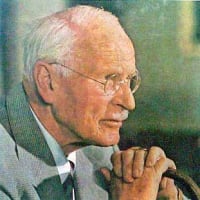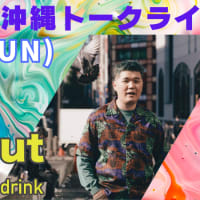
私たちが自分の外に神を設定すると、神は私たちよりも強力であるため、神は私たちを自己から引き離します。私たちの自己は窮地に陥る。しかし、神が自己の中に入り込めば、自己の外にあるものから私たちを奪う。私たちは自分自身の中の単一性に到達する。" - カール・ユング(『赤の書』245ページ
"If we set a God outside of ourselves, he tears us loose from the self since the God is more powerful than we are. Our self falls into privation. But if the God moves into the self he snatches us from what is outside us. We arrive at singleness in ourselves." – Carl Jung (The Red Book, Page 245)
A
自己の経験においては、以前のように「神」と「人」という相反するものが和解するのではなく、むしろ神像そのものの中にある相反するものが和解するのである。それこそが神への奉仕の意味であり、人間が神に提供できる奉仕の意味であり、それによって暗闇から光が現れ、創造主が被造物を意識し、人間が自分自身を意識するようになるのである。~CGユング、MDR p.338
"神はあなたの中にあり、思想や書物の中にはない。
真理は教えられるものではなく、生きているものだ。" ~ヘルマン・ヘッセ
"東洋の宗教的実践の目的は、西洋の神秘主義の目的と同じです。つまり、自我は自己の中に消え、人間は神の中に消えるのである。" ~CGユング、CW11、パラ958。
最初の罪によって損なわれた人間の中の神のイメージは、ローマ人への手紙12:2に従って、神の助けによって「改革」することができます。"そして、この世に合わせるのではなく、心の刷新によって変えられ、何が神の御心であるかを証明するようになりなさい」(RSV)。
個性化の過程で無意識が生み出す全体像は、先験的な元型(マンダラ)の「改造」に似ています。すでに強調したように、自己や全体性の自然発生的なシンボルは、実際には神のイメージと区別することはできない。上記の引用文のギリシャ語テキストには(「変容する」)という言葉が使われていますが、心の「再生」(ἀνακαίνωσις, reformatio)は、実際に意識が変化することではなく、むしろ元の状態に戻ること、つまりアポカタスタシス(復元)を意味しています。このことは、心理学の経験的な発見と全く一致しています。つまり、常に存在する全体性の元型があり、それは意識の視野から簡単に消えてしまうか、あるいは、転換によって照らされた意識がキリストの姿の中にそれを認識するまでは、全く認識されないかもしれないということです。この "アナムネシス(想起) "の結果、神のイメージと一体化した元の状態が復元されます。それは統合をもたらし、本能が異なる相互に矛盾する方向に離れて努力することによって引き起こされる人格の分裂の橋渡しをする。分裂が起こらないのは、人がまだ動物のように本能的な生命を正当に意識していないときだけです。しかし、人為的な無意識、つまり抑圧がもはや本能の生活を反映していない場合、それは有害であり、耐えられないことを証明する。
CGユング『アイオン』第73巻
A
In the experience of the self it is no longer the opposites "God" and "man" that are reconciled, as it was before, but rather the opposites within the God-image itself. That is the meaning of divine service, of the service which man can render to God, that light may emerge from the darkness, that the Creator may become conscious of His creation, and man conscious of himself. ~CG Jung, MDR p.338
"The deity is within you, not in ideas and books.
Truth is lived, not taught." ~Hermann Hesse
"The goal of Eastern religious practice is the same as that of Western mysticism: the shifting of the center of gravity from the ego to the self, from man to God. This means that the ego disappears in the self, and man in God." ~CG Jung, CW 11, Para 958.
The God-image in man that was damaged by the first sin can be “reformed” with the help of God, in accordance with Romans 12:2: “And be not conformed to this world, but be transformed by the renewal of your mind, that you may prove what is … the will of God” (RSV).
The totality images which the unconscious produces in the course of an individuation process are similar “reformations” of an a priori archetype (the mandala). As I have already emphasized, the spontaneous symbols of the self, or of wholeness, cannot in practice be distinguished from a God-image. Despite the word (‘be transformed’) in the Greek text of the above quotation, the “renewal” (ἀνακαίνωσις, reformatio) of the mind is not meant as an actual alteration of consciousness, but rather as the restoration of an original condition, an apocatastasis(復元). This is in exact agreement with the empirical findings of psychology, that there is an ever-present archetype of wholeness which may easily disappear from the purview of consciousness or may never be perceived at all until a consciousness illuminated by conversion recognizes it in the figure of Christ. As a result of this “anamnesis” the original state of oneness with the God-image is restored. It brings about an integration, a bridging of the split in the personality caused by the instincts striving apart in different and mutually contradictory directions. The only time the split does not occur is when a person is still as legitimately unconscious of his instinctual life as an animal. But it proves harmful and impossible to endure when an artificial unconsciousness—a repression—no longer reflects the life of the instincts.
CG Jung, Aion, Para 73



















